
This burner was inspired by the info I received. Vincent sent me a few pages of a mail order info kit (advertising stuff, not construction plans!) from the 1940's about a burner called the "Ursutz" burner. It appeared to be a device that the designer built in his shop and sold through the mail. The advertisement info's short description was enough for me to build something based very roughly on the same principals. While it was far from a set of plans I was able to "wing it" and make something that works.
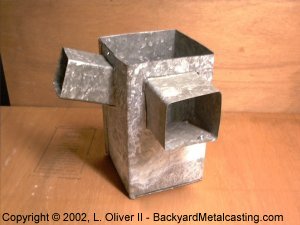
The original burner was made from what looks like a large steel pipe with fittings and ports welded to it. I lacked the ideal material so decided to use sheet metal for the body. Being that square parts are easier to attach than round ones (at least for me) I made everything square and pop-riveted the parts together. This work was done with the crudest of sheet metal working tools (i.e. regular pliers, a wood board to bend and form the corners, blah...blah...blah...)
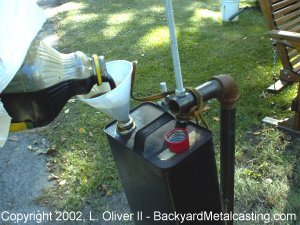
I collected the waste (used) motor oil from the lawn mower and a friend's motorcycle. I put about 1 quart into the burner's fuel tank to compare it to used cooking oil. It lasted about 15 or 20 minutes (equals about 1 U.S. gallon/hour). I prefer used cooking oil, also called WVO (waste vegetable oil) since it's potentially safer to burn. I hope to hook up with a restaurant to supply a few gallons/month. I could also buy kerosene or diesel fuel but that's not recycling...
Metalcaster: I need to change my car's oil every 3000 miles. Better get to it!
Metalcaster's friend: But didn't you change it yesterday? It's only been 11 miles!
Metalcaster: Close enough!
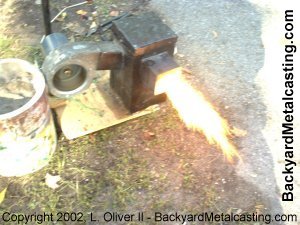
This rig is cheaply made and needs some improvements but I've successfully melted aluminum with it on two occasions prior to these photos. This thing seems to burn very cleanly. The only visible emissions were a little smoke which was actually un-burnt oil vapor which was escaping through the cheaply put together burner body.
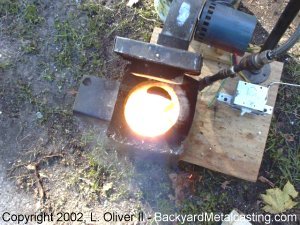
Here's a glimpse inside the hot combustion chamber. You can't really see it but the oil is entering the combustion chamber and being vaporized by the hot interior. It is then ignited into a violent vortex of heat and fire.
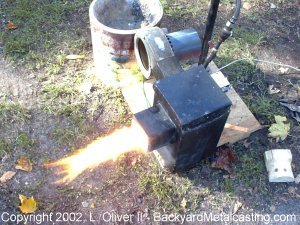
The way this burner system melts metal is simply by pushing the flame exit port up against the hole in the furnace which ordinarily would hold the propane burner (or air blast on a charcoal furnace).
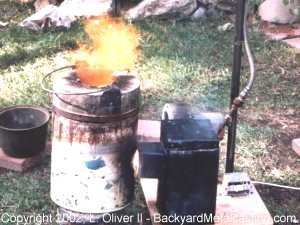
Here's the burner nestled up to the flowerpot crucible furnace. Since charcoal isn't being used as fuel there is more room for the crucible and I can actually get a full load of metal from my 4" diameter crucible with ease. The flame is very dark orange which I think means that there isn't enough oxygen in the mixture. This picture is from a seperate test I conducted using old mixed with NEW motor oil. New oil doesn't seem to burn very well at all (I was expecting that) and left some soot on the furnace lid.
I have no doubt that I could melt brass and bronze with this burner. And with a few improvements I could probably melt iron.